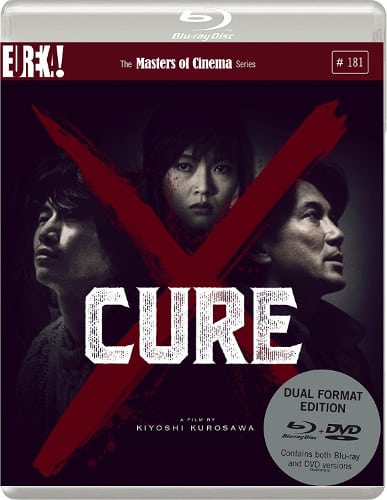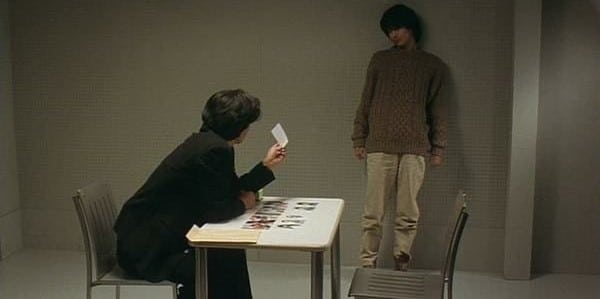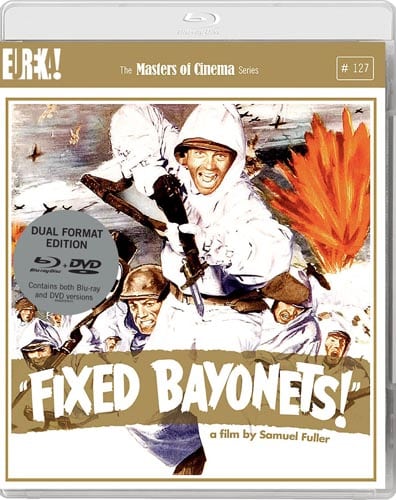Cure (1997)
Directed by: Kiyoshi Kurosawa
Written by: Kiyoshi Kurosawa
Starring: Anna Nakagawa, Kôji Yakusho, Masato Hagiwara, Tsuyoshi Ujiki
AKA KYUA
Japan
AVAILABLE ON DUAL FORMAT BLU-RAY AND DVD: NOW, from EUREKA ENTERTAINMENT
RUNNING TIME: 111 mins
REVIEWED BY: Dr Lenera, Official HCF Critic
Kenichi Takabe is an emotionally repressed police detective with a mentally unstable wife. He investigates a series of bizarre murders in which each victim is killed in the same way with a large ‘X’ carved into their neck, but the perpetrator is different each time. In every case the murderers are caught close to the scene of the crime, and although they readily confess to committing the crimes, they cannot explain what drove them to kill. However, each one of them has come into contact with a strange man, identified as Mamiya from a tag on his coat. Eventually the police pick Mamiya up, but it’s very hard to carry out successive interrogations when the person being interrogated has extremely short term memory loss….
I’ve had to take a week and a half’s vacation from ‘Horror Cult Films’, which means that I’m very late posting this review, a shame because Cure is a film that readers of a website like this should definitely see. I was looking forward to viewing another film from Kiyoshi Kurosawa after watching and reviewing his Pulse last year, also released by Eureka Entertainment, and so here I am after watching what is possibly his most other most acclaimed film Cure. For me, Pulse made a detour in its final act that didn’t quite work for me, but for the most part that film managed to put a fresh spin on the ghost story as well as at times being genuinely frightening. Cure does pretty much the same thing with the serial killer thriller, employing but playing with and subverting several of the cliches that had become well worn by the year of its release 1997, The Silence Of The Lambs having given birth to loads of similar films with only Seven really trying something a bit different. Perhaps the latter is why, despite this being one of the first major films in the J-Horror cycle [and believe me this film is most definitely horror], it failed to garner much interest in the West until the release of Ringu two years later when it finally got seen outside Japan. Like Pulse, Cure seems to add some thoughts on the nature of human existence and they’re not happy thoughts. In fact I’m not sure that Cure can be called “fun” in any way, nor does it provide much in the way of conventional scares or bursts of action which you’d probably expect if it had been made in Hollywood. But its slow grip had me from beginning to end and after a while it really begun to get under my skin. It will do the very same thing to you if you let it. I guess that The Cell and Paperhouse may be points of reference, and possibly even Sean Connery’s finest hour The Offence [sorry 007] – but expect to be continually surprised throughout.
The first scene has a female doctor read out part of the story of Bluebeard to a colleague, then we switch to some rather inappropriate [but no doubt intentionally so] musical backing as a man rips a pipe off a wall of a tunnel, goes home, approaches a woman in bed – and bashes her to death with it. The killing is shown at a distance, as indeed are most of them, or just after the event – though gore hounds have some convincingly gruesome corpses to look forward to. In fact a great deal of the film takes place with the camera observing from far away, something that may take some getting used to but which begins to have an oddly unsettling effect. The perpetrator of the murder is discovered hiding in a cupboard but can’t remember having down the deed. Investigating the case is Kenichi Takabe, and I suppose he’s just a variant on your typical cop hero with a troubled personal life and certain issues of his own – but Koji Yakusho, that superb and very diverse Japanese actor familiar from The Eel and Shall We Dance as well as it seems most of Kurosawa’s films, gives the character some depth, and you know he’s continually on edge so that when he does explode, the effect really does have some power. And then it’s not long after we’ve met our ‘hero’ when me meet our ‘villain’ – though that’s a drastic simplification of the term – in a really haunting scene set on a desolate beach where he appears out of the distance like a phantom to approach the viewer and then another man. The camera keeps them very far away but never cuts, just slowly follows them as they walk and talk while the sound of a still wind dominates the audio. It’s such a simple set-up but eerily effective and by now Kurosawa had me totally hooked.
It’s made fairly obvious quite early on that this odd young man, possibly called Mamiya, is somehow influencing various people to kill other, and it’s made apparent not long after that it’s through some kind of hypnosis, so I haven’t put any spoiler warnings on this review. One especially good scene has him getting a woman doctor to kill someone by bringing forth her feminist instincts. “You’re just a woman, why did you become a doctor”? Takabe and his psychiatrist helper Sakuma seem to be stumped for some time as they follow Mamiya and the trail of bodies all over the city. But eventually they catch up with him and the second half of the film is quite different, the murders mostly stopping but matters getting progressively more dark and disturbing. Takabe keeps on coming up against a brick wall when questioning this person who doesn’t know who he is and who can’t remember anything beyond a few seconds, and could be beginning to ‘lose it’ himself. I actually thought that I had it sussed on how things would play out, but I wasn’t entirely correct. Nonetheless there’s a twisted logic to how things conclude, and I don’t think that the final scene is really as ambiguous as some probably think. But don’t be expected to smile – well, except at the possible irony of the film’s title.
Kurosawa, who also scripted, leaves a fair bit unexplained, which may frustrate a few though I think that in some cases it’s a good decision because explanations can seem ridiculous. The true nature of Mamiya and motivation are left up in the air, Masato Hamigawa tending to play him as a ‘little boy lost’ type of character. He’s often more sympathetic than Takabe, a guy who packs his wife off to a sanitarium yet is told by the doctor there that he’s the one who looks more ill. In fact one really feels for this woman who just wants to spend some time with her always busy husband. Elsewhere the film presents some thought-provoking ideas, such as there not always being a reason for why criminals commit criminal acts and it often being futile to search for one – or indeed to search for meaning in existence altogether. The use of the ‘X’ – or should we say the ‘cross’ – possibly suggests how religion may be the thing that has the most power to make someone do bad things. Maybe any one of us could become a killer if influenced in the right way? The film is packed with characters who are boxed in, trapped from fulfilling their true desires, and Mamiya is the force that can free them. But as in Pulse Kurosawa doesn’t hit you over the head with this kind of stuff and just weaves it into the fabric of his film to be noticed and thought about if you want it to. One thing I found especially interesting is that several motifs and images that would become very familiar in J-Horror were already present in Cure, especially the prominent use of water, usually over-spilling or dripping. This film is also full of objects which become ominous, from a flashing traffic sign to a flickering lighter. When a director is able to make such simple scenes scary, you just don’t need a load of “BOO” moments – though it’s fair to say that some viewers may be disappointed by the lack of typical scares and this really is a film for the patient viewer.
Kurosawa’s film-making style maintains the sense of dread even during some passages that otherwise may not contain an element of fear at all. He likes to show you a room from one angle and later on lets you see more and more of it as the film progresses. The camera often observes things down hallways so characters come in and out of the frame. Things often happen in the periphery of the lens rather than in the center, something which oddly makes some violent moments more shocking rather than less. After all, if we happen to be walking by and see someone being pushed out of a window to their death, we will see the event from a distance and probably not even face on unless we are incredibly quick. Then there’s the set design which in places is truly grimy, this film featuring probably the filthiest looking hospital wall I’ve seen in ages, though I would imagine that most of the film was shot on location, Kurosawa liking to film in grimy, run-down areas of Tokyo. Murky green and dirty yellow often dominate in a film which perhaps does show the influence of Seven in both its nihilism and its look. But it’s a far more restrained piece. In this movie, when our cops run, there’s no loud music [Gary Ashiya’s score is mostly ambient in nature but at times does really chill], no quick camera moves. Even some of the kills are virtually silent. Occasionally even I wished that Kurosawa would pick it up a bit – though there are some sudden cuts signalling that a death [at one moment imagined in an especially upsetting moment] has occurred.
Cure does puzzle a fair bit – there are also some moments which may or may not be imaginary plus an odd fantasy moment set in a seemingly air born bus – but it does scare and will probably stay with you for quite a while after you’ve seen it. As I ponder more upon its hugely haunting effect, I was reminded very strongly of how – for us lovers of this genre – watching horror films can be a kind of exorcism, or at least a possibly subconscious way dealing with our demons.
Rating: 









Cure is a very dark film, but Eureka’s Blu-ray handles both the black and the muted colour palette excellently, and the level of grain is just right. Eureka have ported over an interview from a DVD release and added two interviews of their own. Kim Newman, clearly a fan of the film and its director, is on fine form talking about Kurosawa who seems to have been overshadowed by more flamboyant filmmakers who dabble in similar areas, the nature of his partnership with Yakusho who at times seems to be a representtion of Kurosawa on screen, and – something I failed to pick up on – its similarity to God Told Me Too. Ordinary Demons is the archival interview, Kurosawa discussing the film for 20 minutes, including his inspiration for it and the nature of his framing in which he suggests what’s outside the frame as well as inside it. Then there’s a brand new 17-minute interview with Kurosawa in which he talks about his entry into the film-making business [like Takashi Miike, he started off making lots of direct-to-video movies with Show Aikawa!], his preference for dilapidated locales and his place in Japanese and genre cinema. There’s surprisingly little overlapping from the first to the second interview and both are very interesting.
Arty and austere but very rewarding if you’re game and truly unsettling, Cure is thoroughly recommended on Blu-ray by the Doc.
DETAILS:
* Limited Edition O-Card (First print run only)
* 1080p presentation of the film on Blu-ray, with a progressive encode on the DVD
* Original Japanese Stereo audio (Uncompressed LPCM on the Blu-ray)
* Optional English subtitles
* A new video interview with critic & author Kim Newman
* Ordinary Demons: an archival interview with director Kiyoshi Kurosawa
* a new video interview with director Kiyoshi Kurosawa
* Original theatrical trailer
* A collector’s booklet featuring an essay by Tom Mes








Be the first to comment